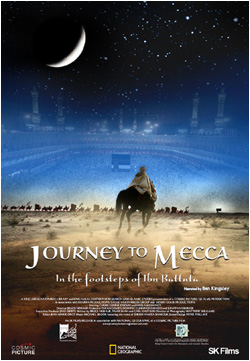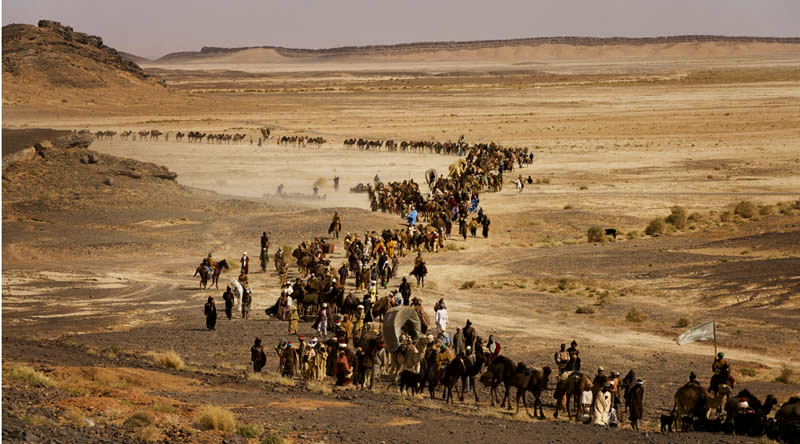Interview: Dominic Cunningham-Reid and Taran Davies of ‘Journey to Mecca’
Posted on January 19, 2010 at 3:55 pm
In 1325 a 21-year-old man named Ibn Battuta set out from his native Tangier on pilgrimage to Mecca that would take him 18 months. And now the story of that journey has become an extraordinary IMAX film, stunningly beautiful, soul-stirring, and genuinely historic.
The Hajj, or obligation to visit Mecca, is one of the core requirements of Islam. Battuta found it to be so important that he would return five more times over the course of travels that would take him 75,000 miles over 29 years. He was the greatest explorer of the Old World, traveling three times further than Marco Polo before returning home to write down the story.
“Journey to Mecca” follows Battuta (played by Chems Eddine Zinoun) on his perilous journey in the context of a compelling picture of Islamic civilization during the 14th century. The story is book-ended by a close-up look at the contemporary Hajj, a pilgrimage to Mecca that draws three million Muslims from around the world every year who perform rituals that have taken place for over 1,400 years. 
Dominic Cunningham-Reid and Taran Davies took time to speak to me on their recent visit to Washington about why the film was important to them and what was involved in getting it made.
It seemed to me that if you had made a list of every single obstacle to making a film, you not only covered them all, you added a few new ones. You had everything but a temperamental star — or maybe that was the camels.
TD: The camels might have been a little temperamental. It was really our personal Hajj in a sense. It just had to be done; I think that was the point. The IMAX challenges are enormous, particularly in this environment. There are millions of people there. Each roll of film lasts only three minutes and then you have to change your magazine. And each roll is incredibly expensive and you need several people to change the magazine. It is an incredibly daunting process in any environment but put that into one of the largest gatherings of people on earth and have them pull that off and it’s almost impossible.
The Hajj has been filmed before but only in low-quality video. It is so difficult to film logistically with the massive amount of people. And so we chose to really rise to that challenge and bring the greatest quality of production to this extraordinary cultural and spiritual event that deserves to be documented in such a fashion.
The images are stunning, exquisitely breathtaking. IMAX was really made for those vistas.
TD: There is some CGI in the film. We re-created Medina and Cairo in the 14th century. But the contemporary Mecca material with the Hajj, that is as it is. You see Mount Arafat on the Day of Standing, the holiest day of the Hajj from a helicopter we’re circling at dusk just a couple of hundred feet above the ground — totally unique, never been done before shot — with literally two million people in that frame. If you asked why would anyone do this, why would anyone make this film, that is the reason.
That is such a powerful image. Tell me about the historians. You worked with a wide variety of experts who did not always agree about some of the most sensitive issues.
TD: One of the crazy things we set out to do was really make the definitive film about the most sacred sanctuary of Islam and its rituals and we needed to get it right. We were working in a very sensitive environment where getting it wrong is not an option. We wanted to make sure that we brought on board as many experts on this subject as possible to make sure that we got it right. We had the leading experts on the Hajj, on Ibn Battuta, on Islamic architecture, on the architecture of Mecca, from all over the world, the United States, Morocco, Saudi Arabia, France, the UK, Kuwait, amongst other countries.
DC-R: The Grand Mosque of the year 1325, we had no visuals to go on. We had history books with verbal descriptions. We had to translate with all of the experts and research into a visual representations. One of the great moments we had is when we had actually sunk 18 pillars of the mosque and then the lead researcher calls up and says, “No, no, they weren’t square, they were round!”
Oh, no!
DC-R: So we had to pull them all out. And start again. Very, very challenging.
The biggest of challenges had to be your subject matter. It could not be more sensitive both from the perspective of believers and people who are ignorant of or hostile to Islam. How did you mediate differences between your experts?
TD: As I look back through time it is such a rosy picture of collaboration, I can’t really recall any disagreements! I think that would be too strong a word to describe what was a collaboration. We needed to receive as much information as we could on the subject of Islam and so we reached out to as many people as we could to provide it. We wanted to get things right from the way the ihram, the white cloth is worn. Do you have the shoulder uncovered or covered? Off-white? How off-white? What material is the cloth made of? Do the pilgrims in the 14th century wear sandals? When they perform the tawaf, what prayers do they say as they are circumambulating the ka’ba. If there were disagreements often among the Muslim community, they have different ways of doing things. It is a very daunting experience for them and many of them don’t know precisely how they are supposed to do it. It was as if we were doing the Hajj because we had to learn how do it right. We were approaching the ka’ba. We had to learn the proper way to perform the tawaf to be able to represent it.
How did your costume designer, Emma Bellocq, do historical research for the film?
DC-R: There were Orientalist paintings that travelers had depicted when they came out. Damascus at the time, the great departure point for caravans, including the caravan that Ibn Battuta went on, there was a wealth of artwork available. These were really cities on the move. We had to break down all of the professions that would be on the caravan. You had people from all walks of life. We looked back and found inventories of people in the caravan who had died, and through that we were able to establish an enormous array of professions, doctors, lawyers, artisans, soldiers, archers, the emir, the people who carried the water in the goatsacks, every single representation of society would be in this moving caravan. They were often as many as thirty thousand animals, with a two-week lag between the first leaving Damascus and the last. That gives you a sense of scale.
TD: That caravan was the largest ever assembled for a dramatic film. No CGI. We had 500 extras and dressing them meant that each one had to show who he was and where he was coming from. The pilgrimage caravan is an example of Islamic cultural heritage. This was the primary mode of transport for travelers and pilgrims on all these roads that led to and from Mecca. We live in the time of the jet age Hajj, as it is known. So we wanted to bring back what it was like in the old days. When we’ve had screenings of the film, Muslims will come out and say, “My grandfather or my great-grandfather told us that we did this and now we know what it is like to travel in such a way.” Every detail had to be right because you can see everything on the IMAX screen.
 So tell me about the camels!
So tell me about the camels!
TD: He’s our camel whisperer!
DC-R: We had just under 1000 animals, I think the final count was 980 camels, horses, and goats. To bring them all together in one place on one day and have them go on this caravan was really extraordinary. They were domesticated but not trained. We had a lot of problems putting the palanquins on them. I’m not sure we understood how they did it back then. It is such a challenge to put this contraption on a camel and have them move smoothly. To get them used to the helicopter because you don’t want them to look up — that was a challenge and we had many flights to get them used to it. One of the great moments was when we were finished filming the people in the caravan said, “We’re ready to go to Mecca.” They felt their journey had just begun.

I just saw this movie, and agree with your assessment. This is a very humane film, exactly what the face of muslim movies should be.
It is unfortunate that Islam today has become known to the rest of the world for the generation of monsters that has been spawned by Islamic militants. When I think of movies about Islamic subjects, I think about the Dutch film director who was murdered on the street because his movie wasn’t sufficiently deferential to Mohammed. This movie portrays the quiet dignity of Islam that tends to get drowned out today.
Thank you very much! I am so pleased you were touched by the film and I hope it gets a wide audience. I am looking forward to seeing it again.
Dear Dominic,
I saw the movie yesterday and the aerial view brought tears to my eyes.
It is a very powerful movie and one can senses your honesty towards the Hajj.
I would love to hear one day that you will be doing this kind of movies for misunderstood countries such as Colombia.
I wish you all the best and hope you will keep trying to give some justice to other subjects as well.
Please, would you be so kind and write my details in your mailing list to follow you and your team?
All the best,
Luz